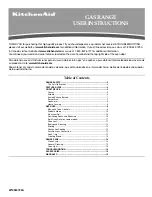
3
3.
Clean clogged burner ports with a straight pin as shown. Do
not enlarge or distort the port. Do not use a wooden toothpick.
If the burner needs to be adjusted, contact a trained repair
specialist.
4.
Replace the burner cap, making sure the alignment pins are
properly aligned with the burner cap.
A. Incorrect
B. Correct
5.
Turn on the burner. If the burner does not light, check cap
alignment. If the burner still does not light, do not service the
sealed burner yourself. Contact a trained repair specialist.
Surface Grates
The grates must be properly positioned before cooking. In the
proper position, the grates should be flush and level. Improper
installation of the grates may result in chipping or scratching of the
cooktop.
To ensure proper positioning, align bumpers on grate bottom with
the indentations in the cooktop.
A. Bumpers
B. Alignment indentations
The surface grates interlock using the hook on one end of the
grate and the indent on the other. To remove the grates, lift the
rear of the left grate off the hook, and then lift the front of the right
grate off the hook and pull apart. To replace the grates, replace
the left grate first. Place the front indent of the right grate over the
hook of the left grate, and then lift the rear of the left grate and
place the indent over the hook on the right grate.
A. Hook
B. Indent
Although the burner grates are durable, they will gradually lose
their shine and/or discolor due to the high temperatures of the gas
flame.
Cookware
IMPORTANT:
Do not leave empty cookware on a hot surface
cooking area, element or surface burner.
Ideal cookware should have a flat bottom, straight sides and a
well-fitting lid, and the material should be of medium-to-heavy
thickness.
Rough finishes may scratch the cooktop or grates/coils. Aluminum
and copper may be used as a core or base in cookware. However,
when used as a base they can leave permanent marks on the
surfaces.
Cookware material is a factor in how quickly and evenly heat is
transferred, which affects cooking results. A nonstick finish has
the same characteristics as its base material. For example,
aluminum cookware with a nonstick finish will take on the
properties of aluminum.
Cookware with nonstick surfaces should not be used under the
broiler.
Check for flatness by placing the straight edge of a ruler across
the bottom of the cookware. While you rotate the ruler, no space
or light should be visible between it and the cookware.
Use the following chart as a guide for cookware material
characteristics.
Cookware
Characteristics
Aluminum
�
Heats quickly and evenly.
�
Suitable for all types of cooking.
�
Medium or heavy thickness is best for
most cooking tasks.
Cast iron
�
Heats slowly and evenly.
�
Good for browning and frying.
�
Maintains heat for slow cooking.
Ceramic or
Ceramic glass
�
Follow manufacturer’s instructions.
�
Heats slowly, but unevenly.
�
Ideal results on low to medium heat
settings.
Copper
�
Heats very quickly and evenly.
�
May leave copper residues, which may be
diminished if cleaned immediately after
cooking.
Earthenware/
Stoneware
�
Follow manufacturer’s instructions.
�
Use on low heat settings.
Porcelain
enamel-on-
steel or cast
iron
�
See stainless steel or cast iron.
Stainless steel
�
Heats quickly, but unevenly.
�
A core or base of aluminum or copper on
stainless steel provides even heating.
































